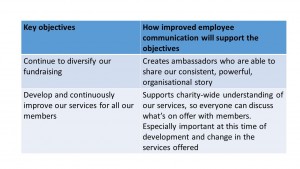Most internal communications people I know would love to have more resource in their team. (Let’s be honest, some would simply like to have a team or even an internal comms-focussed job description.) These internal comms professionals know that even a small increase in resource could enable them to make a bigger difference to their organisations.
Internal comms has changed a lot over the last few years. From the impact of a pandemic, to where and how people work, to the expectations of a changing workforce, to the rapid development of technology. How organisations communicate with their people is affected by all of this.
Many leaders also now recognise that internal comms resource is not a fluffy, nice-to-have. It’s a hard, critical factor in business success. But at the same time, income has dropped dramatically for many organisations and funding will remain a challenge for a long time to come. Difficult decisions have to be made.
So how do you move beyond the beginnings of understanding and make your case for investment that will support your organisation in a challenging present and an uncertain future?
1. Articulate the ‘so what’
Make it really clear how effective internal communication will support the strategic goals of your organisation as we move through a challenging, uncertain future.
This is about making a strong business case, with the emphasis on ‘business’. You have to show how internal communication contributes to what the organisation is actually doing and is not a box-ticking exercise serving its own ends.
For one client, I put together a table with the left-hand column listing the strategic goals and the right side explaining how better communication would contribute. Immediately the senior team could see how internal communication would benefit the things that mattered to them (the objectives).
2. Demonstrate professional skills and knowledge
Refer to resources which demonstrate the skills and knowledge available and required in our profession to show the value that internal comms pros bring.
Even when senior teams understand how better internal communication could make a difference, they don’t fully grasp what that looks like in practice. They don’t know the skills that are required.
If their EA sends out emails, why can’t he put together a newsletter too?
It’s important to present internal communication as a serious discipline and not just a fluffy, nice to have which is easy to dismiss as an optional extra. When your senior team have a better understanding of the professional skills required, it will be clearer to them that investment should be taken seriously too.
It can be a powerful exercise to benchmark the skills you currently have and to assess where you have gaps. This enables you to paint a picture of what is currently possible and what more could be done with more resource.
The Institute of Internal Communication profession map is a really useful tool for doing this and last year I helped a client to use it. The exercise fed into their internal conversations about resource and investment.
3. Pick a project and make it count
When it is hard for senior teams to envisage what they would get from more resource, you can demonstrate how much difference fully effective internal communication can make by going all out with support for a specific project.
For example, this could be a specific project such as the launch of a new fundraising campaign to increase income. Or a restructure that is difficult but unavoidable, so communication has to be sensitive and support your people in a time of difficult change.
You can show that with more resource you would have time to complete more internal comms activities to this level, rather than rushing with a smaller team that is spread too thin.
A few years ago I worked with a client to provide this fuller picture to their senior team in relation to a high profile values project. By experiencing what it would be like to have more in-depth support, executive teams usually feel more inclined to invest.
Make your case
Make no mistake, I’m not saying that it is easy to get more resource for internal comms, especially in the current challenging times. But by using data and insight, practical demonstrations and examples of best practice elsewhere, it can be done.
I’d love to hear your experiences of asking for more internal comms resource at your organisations. If you’d like support with effective internal comms on a short term basis to help make the case longer term, get in touch for a conversation.
Until next time
Sarah


